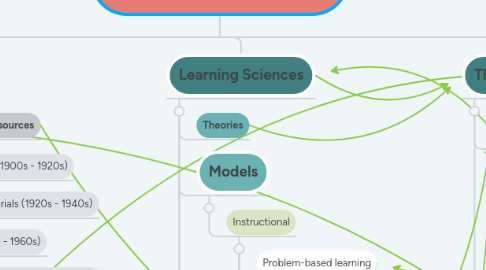
1. Concepts
1.1. Systematic Processes or "Steps"
1.1.1. Analysis
1.1.1.1. Goals
1.1.1.2. Objectives
1.1.2. Design
1.1.2.1. Systematic
1.1.3. Development
1.1.3.1. Production
1.1.4. Implementation
1.1.5. Evaluation
1.1.5.1. Formative
1.1.5.2. Feedback
1.1.5.3. Revision
1.1.5.3.1. Summative
1.2. Methodologies
1.2.1. Task Analysis (1940s)
1.2.2. Criterion-referenced testing (1960s)
1.2.3. Objective specification (1960s)
1.2.4. Formative evaluation (1960s)
1.2.5. Gagne's Nine Events of Instruction
1.3. Concerns
1.3.1. Assessment
1.3.2. Interaction
1.3.3. Motivation and Volition
1.3.3.1. Intrinsic or extrinsic
1.3.3.2. Trait or state
1.3.3.3. Affective or cognitive
1.3.3.4. Strategies
1.3.4. Engagement
2. Theories
2.1. Learning Theories
2.1.1. Behaviorism
2.1.1.1. Objectives
2.1.1.2. Practice
2.1.1.3. Feedback
2.1.2. Cognitivism
2.1.2.1. Cognitive Information Processing Theory
2.1.2.1.1. Sensory
2.1.2.1.2. Working
2.1.2.1.3. Long-term
2.1.2.2. Schema Theory
2.1.2.2.1. Automation
2.1.2.3. Cognitive Load
2.1.2.4. Situated Learning
2.1.2.4.1. Meaningful
2.1.2.4.2. Community of practice
2.1.2.4.3. Anchored instruction
2.1.2.5. Gagne's Theory of Instruction
2.1.3. Constructivism
2.1.3.1. Concepts
2.1.3.1.1. Collaboration
2.1.3.1.2. Authentic engagement
2.1.3.1.3. Support
2.1.3.1.4. Reflection
2.1.3.2. Projects
2.1.3.2.1. Flipped learning
2.1.4. Connectivism
2.2. Strategies for Instruction and Design
2.2.1. Structure-process-outcome Theory
2.2.2. Social Interdependence Theory
2.2.3. Play Theory
2.2.3.1. Flow Theory
3. Trends
3.1. Ethical Considerations
3.2. Performance Improvement Movement
3.2.1. Performance Support
3.2.1.1. On-the-job performance
3.2.1.2. Noninstructional solutions to performance problems
3.2.2. Human Performance Improvement
3.2.2.1. Systematic processes- Interventions-Improvements
3.2.2.2. Behavior Engineering Model
3.3. The Internet
3.3.1. Online learning courses
3.3.1.1. Business
3.3.1.2. K-12
3.3.1.3. Higher education
3.3.1.4. Industry
3.3.2. New(er) Technologies & Platforms
3.3.2.1. MOOCs
3.3.2.2. Game-based learning
3.3.2.3. M-learning
3.3.2.3.1. 4 C's: Content, Compute, Communicate, Capture
3.3.2.4. Social Media
3.3.2.5. Rich Media
3.4. Informal Learning
3.4.1. Facilitating skill and knowledge acquisition through
3.4.1.1. Social media
3.4.1.2. Mobile devices
3.4.1.3. Performance support tools
3.5. Simpler Design Models
3.5.1. Effective learning delivered through efficient solutions
4. Characteristics
4.1. Instructional Media Resources
4.1.1. Visual materials (1900s - 1920s)
4.1.2. Audiovisual materials (1920s - 1940s)
4.1.3. Television (1950s - 1960s)
4.1.4. Computers and digital devices (1950s - present)
4.2. Instructional Design
4.2.1. Media materials to present instruction (from 1900s)
4.2.2. Process : Finding solutions to learning problems or goals (popularized in 1950s-1970s)
4.2.2.1. Systematic instructional design (steps)
4.2.2.2. Improved performance through facilitated learning (current)
4.2.3. Incorporation of learning theories (from 1990s)
4.2.4. Models
4.2.4.1. Systems approach
4.2.4.1.1. ADDIE process
4.2.4.1.2. SAM
4.2.4.1.3. Pebble-in-the-pond
4.2.4.2. General Systems Theory
4.2.4.3. Evaluation Models
4.2.4.3.1. CIPP Model
4.2.4.3.2. Rossi's Five Domains
4.2.4.3.3. Theory-driven Model
4.2.4.3.4. Training Evaluation Model
4.2.4.3.5. Success Case Model
4.2.4.3.6. Evaluation and Management
4.2.5. Based on research
4.2.5.1. Development of instructional design methodologies
4.2.6. Attributes
4.2.6.1. Student-centered
4.2.6.2. Goal-oriented
4.2.6.3. Creative
4.2.6.4. Meaningful performance
4.2.6.5. Outcomes
4.2.6.5.1. Measurable, Reliable, Valid
4.2.6.6. Process
4.2.6.6.1. Empirical, Iterative, Self-correcting
4.2.6.7. Team effort
5. Learning Sciences
5.1. Theories
5.2. Models
5.2.1. Instructional
5.2.1.1. Problem-based learning
5.2.1.2. Case-/Scenario-based learning
5.2.1.3. Cognitive apprenticeship
5.2.1.4. Interactive learning environments
5.3. Contexts
5.3.1. Piaget
5.3.1.1. Play: Accommodation and Assimilation
5.3.2. Vygotsky
5.3.2.1. Zone of proximal development
5.3.2.2. Distributed intelligence
5.3.3. Situated learning
5.3.4. Anchored instruction
5.4. Research
5.4.1. On thinking and knowing
5.4.1.1. Memory
5.4.1.2. Multiple Intelligences
5.4.1.3. Expert thinking
5.4.2. On learning processes
5.4.2.1. Conceptual change
5.4.2.2. Literacies
5.4.2.3. Identity
5.4.3. On learning environments
5.4.3.1. Supportive: scaffolding
